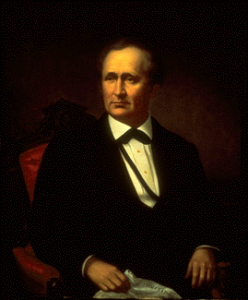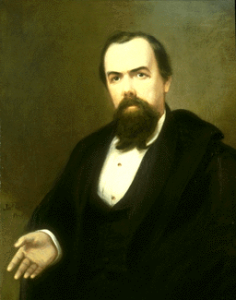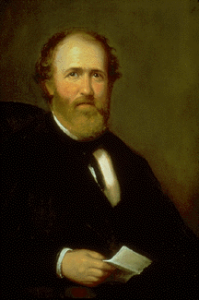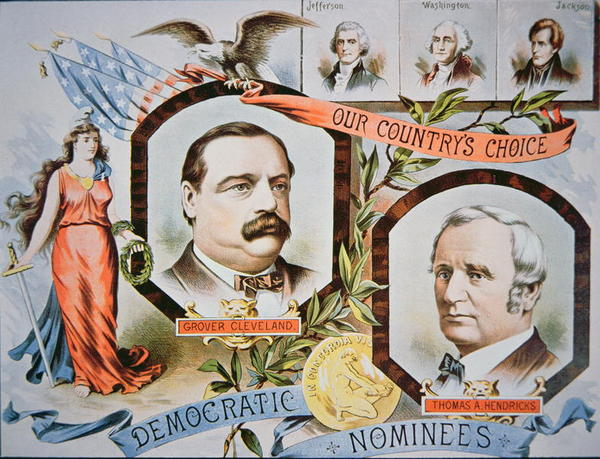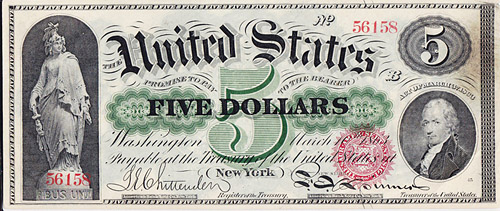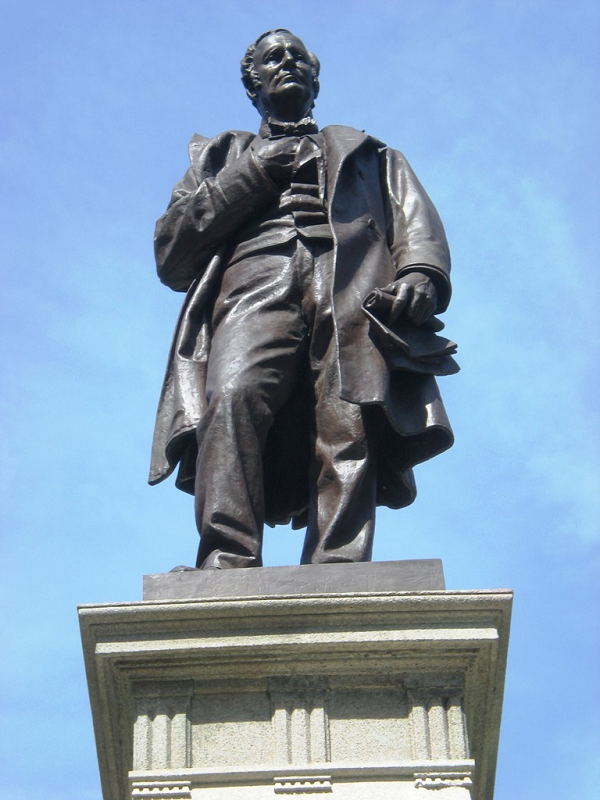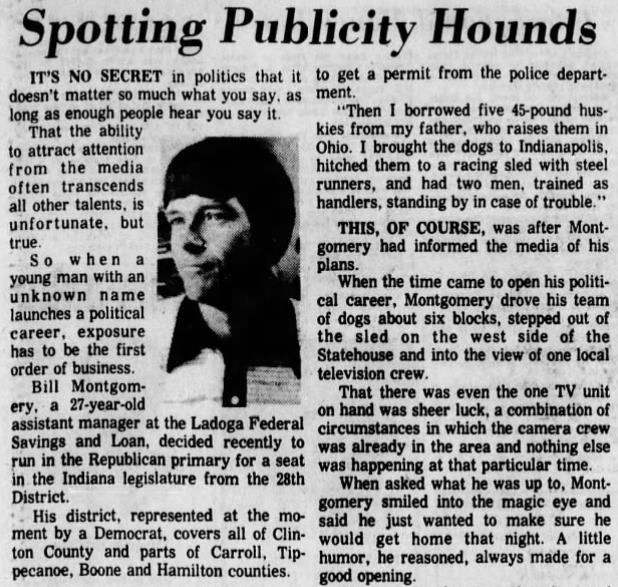
When it comes to mobilizing a political campaign, candidates are always trying to stand out to get publicity, whether it be appearing in commercials, putting up billboards, or simply knocking on doors. Visibility is always crucial to getting elected to office. However, never in the history of the Indiana General Assembly had a candidate utilized a blizzard to help them get elected—that is, until 1978. This is the story of Bill Montgomery and a storm that made history.
It all began that winter. Bill Montgomery at this time was a law student trying to figure out what to do with his life. On one casual evening hanging out with friends in Indianapolis, he posed to them the following question: “What do you folks think I’m good at?” Eagerly, several of Montgomery’s friends chimed in that they felt he would be good in politics. And then, the stars began to align in Montgomery’s mind. Recently, he had watched “The Candidate,” a film about a lawyer who is recruited to run for office, and now his friends were encouraging him to launch a political career. So, Montgomery began to reflect more on the idea in the days to come, eventually deciding to give it a shot. In turn, he began reaching out to local community members connected to politics to see what may be possible.
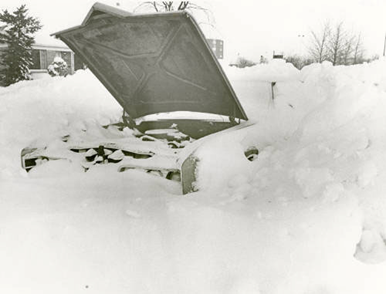
After talking to several people, Montgomery officially decided to throw his hat in the ring, despite being unsure of his chances due to the lack of name recognition. Thinking about the need for publicity, Montgomery started brainstorming (no pun intended) ideas with his college roommate, Mel, at DePauw University, while simultaneously a blizzard swept across Indiana. According to Montgomery’s Indiana Legislative Oral History Initiative interview, Mel brought up the fact that Montgomery’s father once completed the Iditarod sled dog race in Alaska and still had sled dogs. Mel proposed, “Why don’t you play on this blizzard and you know, come up with some energy themes, and drive a team of sled dogs to the statehouse and file your declaration of candidacy?”
Initially, Montgomery considered the idea too outlandish, but gave it some thought. Not long after, Montgomery started to warm up (pun intended) to the possibility of launching possibly the most unique candidacy announcement in the history of the Indiana General Assembly. He contacted his father, who agreed to loan him several sled dogs to transport him to the statehouse. However, Montgomery still had to ensure that this would generate good publicity, so he decided to utilize his connection as the sports editor of the campus paper, The DePauw, and informed the Sports Information Director at DePauw Pat Aikman about his plan. Aikman loved this idea and informed his contact at the Indianapolis Star, Tom Keating, about the plan. With his plan in motion, Montgomery managed to obtain a police permit for his six-block trip and convinced two people to help handle the dogs.
Thus, on February 16, 1978, the day had finally arrived to make campaign history in Indiana. Little did the City of Indianapolis know that Saint Nick was not the only man with a sleigh to make an appearance this winter. And so it began. At the young age of 27, Montgomery careened down snow-packed Senate Avenue with his sled dogs to announce his campaign for the Indiana House of Representatives. To his own surprise, one TV crew was already in the area when he arrived. This resulted in Montgomery being televised, creating buzz across the state about this mysterious new legislative candidate. Additionally, the following week Keating featured Montgomery in a Star article titled “Spotting Publicity Hounds.” Keating concluded that, while unfortunate, the “ability to attract attention from the media often transcends all other talents. . . . So, when a young man with an unknown name launches a political career, exposure has the be the first order of business.”[i]
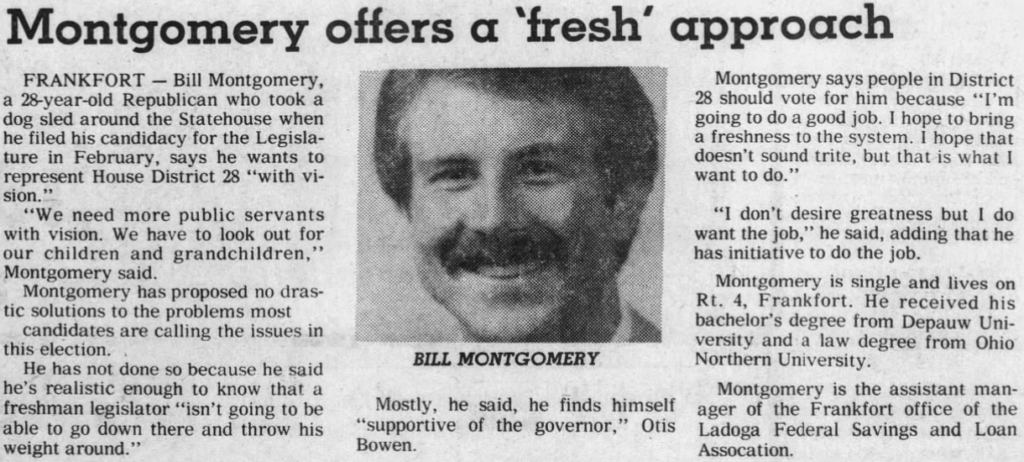
In the Star article detailing Montgomery’s innovative campaign strategy, Montgomery told the paper “’I know this was a gimmick. I needed something to set me apart. Maybe this isn’t the way it should be done, but I couldn’t think of anything else.’”[ii] Later, he took part in the Republican Primary in his district and went to bed learning he had lost by only four votes. The next morning though, his phone rang and shockingly he was told that the results were misreported. In fact, he had won the Republican Primary by eight votes.[iii] Montgomery would also win the general election, earning a seat in the Indiana House of Representatives. He served from 1979 to 1982 before Governor Robert Orr appointed him to the Public Service Commission (known today as the Public Utilities Commission). However, he’ll likely be best remembered for his candidacy announcement, which serves as a reminder that sometimes fortune favors the bold in politics.
[i] Thomas R. Keating, “Spotting Publicity Hounds,” Indianapolis Star, February 21, 1978, 19, accessed ProQuest.
[ii] Ibid.
[iii] Thomas R. Keating, “Newcomers Hooked,” Indianapolis Star, May 4, 1978, 38, accessed ProQuest.

